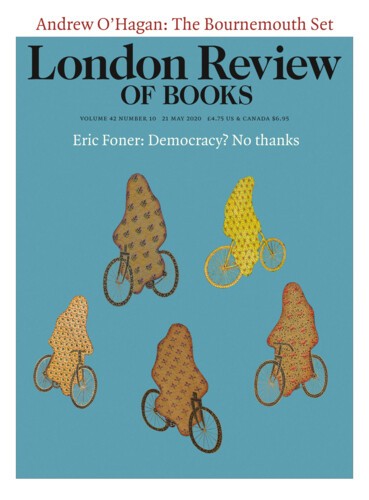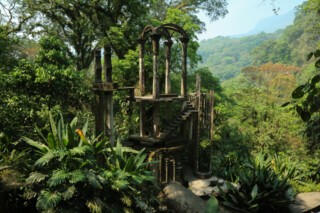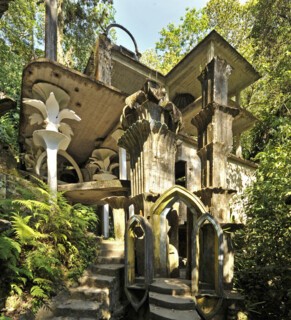Edward James was charming, eccentric, generous and immensely wealthy. For most of his life, his greatest talent was placing himself in interesting situations, often having used his wealth to make them happen. In 1931, he was the first to publish John Betjeman, who had been a fellow student at Oxford. In 1933 he financed the final collaboration between Bertolt Brecht and Kurt Weill. When Salvador Dalí was nearly suffocated by the diving suit he wore to the International Surrealist Exhibition in London in 1936, it was James who prised it off with a billiard cue. The back of his head features twice – once in the mirror – in René Magritte’s Not to Be Reproduced (one of Magritte’s most reproduced works). In 1937 he bought in advance everything Dalí painted that year, a gesture that, unlike most of his patronage, increased his net worth considerably.
James wrote poetry, some of which he had privately printed, but for the first half of his life he mostly produced, published and facilitated the work of others. It was not until the 1960s, in Mexico, that he began work on his enduring creation: a surrealist sculpture park in the jungle-covered hills of Xilitla above the Gulf coast. Over the next two decades, he expanded it to fill a twenty-acre valley around a cascade of waterfalls and pools. Las Pozas (‘the pools’) turned out to be the perfect project for someone with a fertile imagination and almost unlimited resources who was far more interested in starting things than finishing them. One structure after another rose among the ferns, magnolias, bromeliads and mango and banana trees: tier on tier of platforms from which sprouted nonsensical concrete shapes and flourishes, wrought-iron gates leading to secret gardens, staircases and bridges leading nowhere. When the limits of gravity were reached, a structure would be abandoned and another begun.
James inherited his fortune from his father, William Dodge James, a railroad and copper magnate, though many suspected that his real father was Edward VII, his godfather and a frequent guest at the family estate at West Dean in Sussex. (James didn’t believe the rumours: his own theory was that his mother was Edward VII’s daughter.) In 1931 he married the Viennese dancer Tilly Losch, but it was apparently only on their honeymoon in Hawaii that she realised he was madly in love with her: up to that point she had assumed he was gay and simply wanted a wife as camouflage. He spent the next three years trying to win her affection, eventually mounting an entire ballet season in Paris as a showcase for her. He commissioned Weill and Brecht to create a new opera-ballet, The Seven Deadly Sins, featuring Losch opposite Lotte Lenya, Weill’s wife. But Losch treated him with disdain and the marriage ended bitterly. James created a scandal by publicly contesting the divorce settlement on grounds of adultery, but won conclusively. Losch was ordered to pay costs.
During the 1930s James retreated to the Lutyens-designed Monkton House at West Dean, giving it a makeover inspired by Dalí. He painted the exterior purple and added fibreglass bamboo columns; the country cottage interior was replaced with migraine-inducing swirly wallpaper, a red plush sofa modelled on Mae West’s lips and a carpet patterned with the pawprint of his Irish wolfhound. But James wasn’t ready to settle down as a bachelor recluse. In 1939 he travelled to New York to manage Dalí’s exhibit at the World’s Fair, and then to California. He set himself up in style in Malibu and joined the Heard-Huxley-Isherwood circle, but soon got bored with their humourless mysticism and Hollywood’s shallow expat scene.
He took to driving in the desert and making forays into Mexico, which André Breton had recently described as ‘the most surrealist country in the world’, one whose mythological past wasn’t overwritten by modernity but subverted it in endlessly surprising ways. He hired a local guide of Yaqui descent, Plutarco Gastélum Esquer, and together they drove remote country roads, sleeping bags in the back seat, stopping wherever they found themselves at nightfall. Eventually they reached the small market town of Xilitla in the Sierra Gorda, a range of rugged hills where the desert of the central highlands slopes down towards the humid Gulf Coast, and cactus and thorn bushes give way to lush temperate forest, flickering with butterflies and hummingbirds.
James bought a plot on the steep road that descends from Xilitla’s town plaza, where Gastélum supervised the construction of a house to his design. It evolved into a grand Modernist folly: a ground floor with patio, swimming pool, verandah and an opulent dining room, the upper storeys rising haphazardly like toy brick towers, with vertiginous spiral staircases ascending to domed crow’s nests with stained glass windows and panoramic views over the surrounding forests and mountain peaks beyond. Gastélum married a local woman and they moved into the house; their four children became James’s adopted and extended family, and on Sundays the neighbours were invited over for poolside parties.
Over the next decade or so James settled into his new life, indulging his twin passions of gardening and keeping a menagerie. He landscaped the valley of Las Pozas and planted thousands of orchids, tending them accompanied by several parrots, which perched on his head and shoulders. He travelled around Mexico collecting exotic animals, including monkeys and boa constrictors, a kinkajou and an ocelot. In Mexico City he socialised with visiting Surrealists and other artists who had fled the war in Europe. He became a patron of Leonora Carrington, who was also starting a new life there after the collapse of her romance with Max Ernst. Carrington was a frequent visitor to Xilitla, where she painted frescoes of minotaurs on the walls of the new house. He had by this time acquired one of the largest private collections of Surrealist art – not, he insisted, out of a desire to own it, but to support struggling talents. He bought several pieces from Magritte before his work was widely recognised, and from Dalí before he became stratospherically famous. Though Picasso was already wealthy, James bought a few of his paintings out of friendship (Picasso maintained that James was crazier than all the Surrealists put together).
The sculpture garden at Las Pozas wasn’t conceived until James had been living at Xilitla for fifteen years. In 1962 a freak snowstorm, the first in living memory, killed his beloved orchids and he determined to start again, this time with a project the weather couldn’t destroy. He began constructing multi-level platforms and, with Gastélum as his chief engineer, moulding concrete in abstract organic shapes modelled on the flowers and leaves that filled the valley, their arrangements inspired by the impossible architecture in the paintings of Dalí and Carrington. As the structures grew, so did his ambitions for them. One was projected to rise to eight storeys, crowned with a rotating concrete dodecahedron. There was even a plan to enclose the entire ensemble in a wire frame that would span the forest canopy, transforming the valley into a gigantic aviary.
James was filmed in the late 1970s, striding round Las Pozas in a sweater and a tattered dressing-gown, surmounted by parrots (The Secret Life of Edward James can be seen on YouTube). When asked what motivated him, he replied: ‘Pure megalomania!’ He was having his second childhood, he said, though he wasn’t sure the first had ever ended. The structures evolved continually. Concrete was the perfect material for this kind of freewheeling construction: poured into wooden moulds it could be used to create an endless series of duplicated shapes and motifs. Workers were cheap and plentiful, and before long Las Pozas was employing all of the available workforce in the area, and Xilitla became noticeably richer than neighbouring towns. James had found his perfect art form, grandiose and pointless: architecture liberated from the usual imperatives of form and function. The structures became known as ‘The House with Three Storeys that Might Be Five’ or ‘The House Destined to Be a Cinema’, working titles frozen in permanent incompleteness.
As the project became all-consuming, James divested himself of his past life. In 1964 he sold his art collection, ploughing the money into his jungle folly. He transferred the estate at West Dean to a foundation that ran it as a craft college, teaching gilding, calligraphy and clock repair. He continued to build at Las Pozas until his death in 1984, after which it was bequeathed to the Gastélum family. It remains his lasting monument and a source of pride to many Mexicans. When I visited in January, it was thronged with visitors from Mexico City and the resorts of the Gulf coast. It’s still a major local employer: jungle parks require constant maintenance. Age has helped the concrete blend into its surroundings, the surfaces softened with leprous blotches of lichen and the corners wreathed in tangled vines and ivy. Its incompleteness now looks deliberate, an open-ended engagement with the landscape that inspired its creation.
Send Letters To:
The Editor
London Review of Books,
28 Little Russell Street
London, WC1A 2HN
letters@lrb.co.uk
Please include name, address, and a telephone number.



